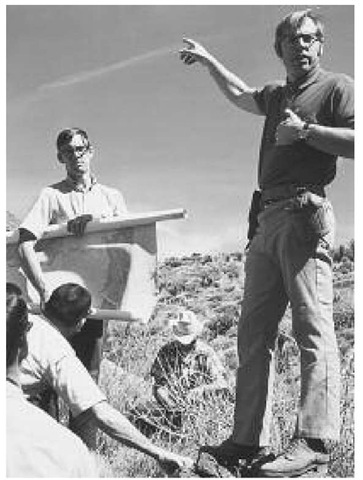(1934- ) American Structural Geologist, Tectonics
With the vast number of highly talented geologists doing research in the frontier field of tectonics, progress has become one of inches rather than the leaps and bounds that it started out with. For that reason, it is always astonishing when some geologists seem to be able to make those impressive advances in spite of the usual slow pace. Clark Burchfiel is the epitome of that geologist. Although Burchfiel has concentrated the bulk of his efforts on the southwestern United States and Tibet, one of the reasons for his great success is that he will travel to the ends of the Earth to address a problem in the ideal example. His travels have additionally taken him to the Alps of eastern Europe, the Scandinavian Caledonides, and the Peruvian, Bolivian, and Colombian Andes. Typically, his approach to these problems is with detailed field geology coupled with geophysical data where available.
Clark Burchfiel leads a field trip to the Clark Mountains, Basin and Range Province, in California with Greg Davis (background) in 1971
Some of the topics that Clark Burchfiel is best known for include a pull-apart (extensional) origin for Death Valley, California, many studies on the plate tectonic evolution of the western Cordilleras, and studies contrasting plate subduc-tion and convergence in the Carpathians, the Caledonides, and the Cordilleras. The studies he is most famous for in recent years are the defining of different types of extension as plates are broken apart during the formation of an ocean basin. This work with student Brian Wernicke established a whole new vigorous direction in geology. He and student Leigh Royden found concurrent normal faulting with parallel reverse faulting in the Himalayas. Prior to this the generally accepted idea was that all faults in a compressional area should be reverse or if there are normal faults, they lie perpendicular to the reverse faults. This work showed that mountains can reach only a certain height and thereafter the crust collapses any way it can. Many tectonic geologists had to rethink their models and start reexamining their field areas as a result of this work. This response of the profession is common after Burchfiel publishes a paper.
Clark Burchfiel was born on March 21, 1934, in Stockton, California. He attended Stanford University, California, where he earned a bachelor of science degree and a master of science degree in geology in 1957 and 1958, respectively, in addition to playing varsity football. He earned his Ph.D. from Yale University, Connecticut, in structural geology and tectonics in 1961 under advisement of JOHN RODGERS. He earned the Silli-man Prize for his work. Burchfiel worked as a geologist with the U.S. Geological Survey during his final year at Yale University before accepting a position at Rice University, Texas, in 1961. He was named a Carey Croneis Professor of geology from 1974 to 1976. In 1977, he joined the faculty at Massachusetts Institute of Technology and was named Schlumberger Professor of geology in 1984, a chair that he still holds today. He held several exchange and visiting professor positions during his career at the Geological Institute of Belgrade, Yugoslavia (1968), the Geological Institute of Bucharest, Romania (1970), the Australian National University (1976), the University of Athens, Greece (1986), and University of Lund, Sweden (1992). Burchfiel married fellow geologist and Massachusetts Institute of Technology professor Leigh Royden in 1984; they have four children.
Clark Burchfiel has had an extremely productive career publishing well over 100 articles in international journals and professional volumes. Many of these papers are benchmark studies that are repeatedly cited in other scientific articles. In addition to his own superb research, he has men-tored many of the top geologists in the field of tectonics today. Thus his influence has even a more far-reaching effect. Burchfiel has been recognized for his contribution to the field with numerous honors and awards. He has been a member of the National Academy of Sciences since 1985 and was a Guggenheim Fellow from 1985 to 1986. He is a Fellow of the American Academy of Arts and Sciences and an honorary Fellow of the European Union of Geologists as well as a member of the Chinese Academy of Sciences. He received many awards from professional societies including the prestigious Career Contribution Award from the Structural Geology and Tectonics Division of the Geological Society of America in 1996. Burchfiel served as editor for the journal Tectonics and is on the editorial board for Tectonophysics as well as prominent journals in Norway, Switzerland, Germany, and China.

